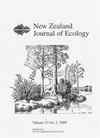Moths can transfer pollen between flowers under experimental conditions
IF 1.4
3区 环境科学与生态学
Q3 ECOLOGY
引用次数: 2
Abstract
: To be considered an effective pollinator, a floral visitor must not only be able to remove pollen but also transfer this pollen to a receptive conspecific stigma. While studies of diurnal pollination are commonplace, our understanding of the effectiveness of nocturnal pollinators is limited largely because of the difficulties of doing these studies at night. As a result of this, the way in which moths transfer pollen between flowers has been understudied globally, despite many authors suggesting they could be significant contributors to pollination. Here, we tested whether moths are capable of transferring pollen between flowers under experimental conditions using a fluorescent pollen-tracker powder. A flower-feeding taxon (Noctuidae: Ichneutica plena ) and non-feeding taxon (Hepialidae: Wiseana spp.) were contained overnight with flowering shoots of putatively moth-pollinated Leptospermum scoparium and Pimelea prostrata ( I. plena only), and putatively bird-pollinated Crocosmia × crocosmiiflora . Moths were able to transfer pollen tracker between flowers for both of the putatively moth-pollinated species, while no pollen tracker was removed from putatively bird-pollinated flowers. Both the feeding and non-feeding moth taxa were able to transfer pollen tracker between flowers; however, the feeding taxon could be considered a more effective pollinator because of the greater proportion of individuals both carrying and transferring pollen tracker compared with the non-feeding taxon. This study provides experimental evidence that moths may contribute to the pollination of L. scoparium and P. prostrata , and suggests a reassessment of the pollination ecology for these species is warranted在实验条件下,蛾可以在花朵之间传递花粉
:要被认为是一种有效的传粉者,访花者不仅必须能够去除花粉,而且还必须将花粉转移到可接受的同种柱头上。虽然对昼夜授粉的研究很常见,但我们对夜间授粉者有效性的了解有限,主要是因为在夜间进行这些研究很困难。因此,尽管许多作者认为飞蛾可能是授粉的重要贡献者,但全球对飞蛾在花朵之间传递花粉的方式研究不足。在这里,我们使用荧光花粉追踪器粉末测试了蛾类在实验条件下是否能够在花朵之间传递花粉。一个以花为食的分类单元(Noctuide:Ichneutica plena)和非以花为生的分类单元,(Hepiliadae:Wiseana spp.)与假定为飞蛾授粉的Leptispermum scopearium和Pimelea prosta(仅限I.plena)以及假定为鸟类授粉的Crocosmia×Crocosmiflora的开花芽一起过夜。对于这两种被认为是蛾类授粉的物种,蛾类能够在花朵之间转移花粉跟踪器,而从被认为是鸟类授粉的花朵上没有移除花粉跟踪器。食蛾和非食蛾类群都能够在花之间传递花粉跟踪器;然而,与非取食分类单元相比,取食分类单元可以被认为是更有效的传粉昆虫,因为携带和转移花粉跟踪器的个体比例更大。这项研究提供了一些实验证据,证明蛾类可能有助于东花和匍匐茎的授粉,并表明有必要重新评估这些物种的授粉生态
本文章由计算机程序翻译,如有差异,请以英文原文为准。
求助全文
约1分钟内获得全文
求助全文
来源期刊

New Zealand Journal of Ecology
环境科学-生态学
CiteScore
3.00
自引率
12.50%
发文量
35
审稿时长
>36 weeks
期刊介绍:
The New Zealand Journal of Ecology is a biannual peer-reviewed journal publishing ecological research relevant to New Zealand/Aotearoa and the South Pacific. It has been published since 1952 (as a 1952 issue of New Zealand Science Review and as the Proceedings of the New Zealand Ecological Society until 1977). The Journal is published by the New Zealand Ecological Society (Inc.), and is covered by Current Contents/Agriculture, Biology and Environmental Science, GEOBASE, and Geo Abstracts.
 求助内容:
求助内容: 应助结果提醒方式:
应助结果提醒方式:


